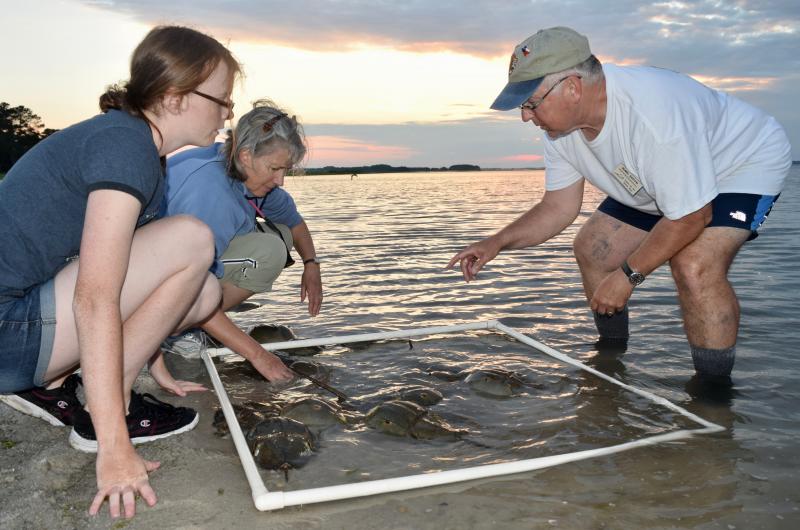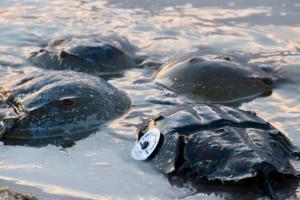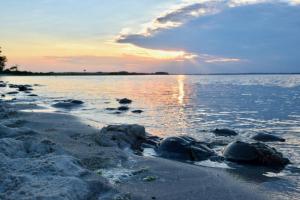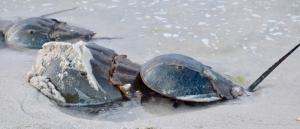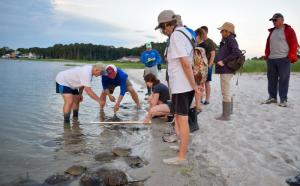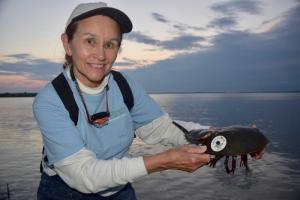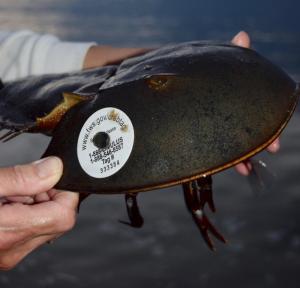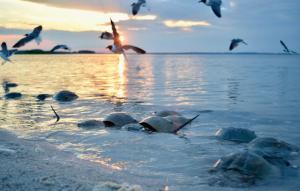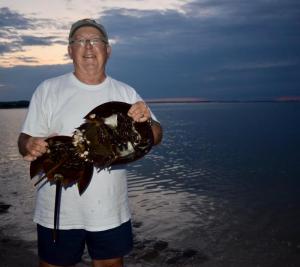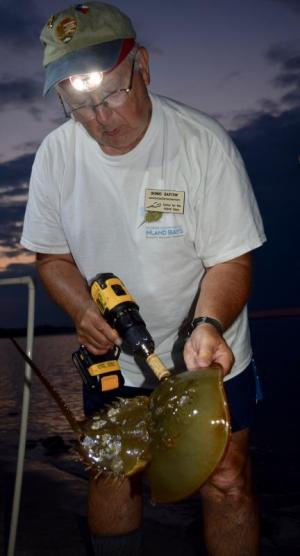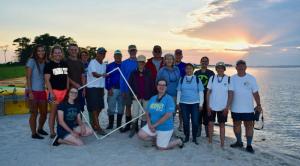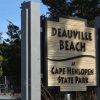As small waves lapped quietly along the shore of Indian River Bay, dozens of barnacle-adorned horseshoe crabs congregated at the height of the ancient creature's annual spawning season.
Laughing gulls scuttled in their wake, scooping up the tiny, green eggs nestled in the sand. Behind them, a crew of volunteers from the Delaware Center for the Inland Bays emerged from the woods, headlamps hanging from their necks, ready to survey and tag this year's population of mating horseshoe crabs.
The quarter-mile trek seemed odd with the waning sun pouring through the trees, said volunteer Elaine Weil. She's used to making the short hike in the dark, since many evening high tides during the spawning season at the James Farm Ecological Preserve came closer to midnight. The high tides bring the mating crabs to shore, where each female lays clusters of a few thousand eggs, many of which will be eaten before they hatch.
Weil said it's her first year volunteering for a horseshoe crab count, and she decided to lend a hand to learn more about the creatures in an effort to educate her students at Sussex Central High School.
“I'm always trying to tie science to real-life experiences,” the Seaford resident said. “So now, when my students are walking down the beach and see horseshoe crabs on the sand, they'll be able to tell their friends and families why they're so important.”
The Inland Bays don't see the tens of thousands of crabs piling on top of each other for the moonlight mating ritual like mid-Delaware Bay beaches, which boast the world's largest population of spawning horseshoe crabs.
In mid-June, volunteers counted 944 crabs along the small James Farm beach, less than half of what the volunteers at the ocean beach at Tower Road have seen in recent weeks. The Center for the Inland Bays has six teams counting at six locations along the three Inland Bays; there are more than 90 survey sites along the Delaware and New Jersey sides of the Delaware Bay.
“The more people who know about all this and can be good environmental stewards, the better it is for all of us,” said longtime volunteer Jean Sarg, who usually counts crabs along the Delaware Bay, at the St. Jones Reserve near Dover.
Sarg has witnessed the mass orgy of crabs along the Delaware Bay, but the smaller, calmer beaches along the Inland Bays also provide invaluable nesting grounds – and feeding sites – for the crabs and their entourage of shorebirds.
The crabs' eggs provide invaluable food sources for nearly a dozen shorebird species, including the threatened red knot. The tiny red knot, migrating more than 9,300 miles each summer from the southern tip of South America to its Arctic breeding grounds, relies on the sustenance provided by the eggs found along the Delaware Bay. In the short time the birds rest and feast, they double their weight and store enough energy to finish their long flight.
Horseshoe crabs also provide bait for commercial fishermen – this year's quota was met June 22 with more than 160,000 male crabs commercially harvested. The crabs are mainly used as bait for American eel and whelk or conch; commercial harvesters are prohibited from taking female horseshoe crabs.
But it's the crabs' blue blood that really brings in the big bucks. A protein in the blood is used to test pharmaceutical and medical devices for human safety, making one quart of the blood worth about $15,000.
Their importance to both humans and the coastal ecosystems they live in is one of the reasons state agencies and nonprofit conservation groups survey their numbers annually. In the 1990s, poor fishery management devastated horseshoe crab populations, resulting in a ripple effect that left birds, like the red knot, more vulnerable.
“I think citizen science is coming more into the forefront now,” Sarg said, stating that it's important for the public to understand the different roles of horseshoe crabs. “Now, especially in times when budgets are being cut, volunteers are keeping some agencies running. Volunteers are the lifeblood of what we do.”
To learn more about horseshoe crabs, go to inlandbays.org or horseshoecrab.org.
If you see a horseshoe crab with a tag, call U.S. Fish & Wildlife Service at 888-546-8587 to share information including the tag number, the horseshoe crab's condition and where it was found. People who find tagged horseshoe crabs – commonly referred to as “horseshoe crab resights” - also can share information at www.fws.gov/crabtag. The first time you report a resight, Fish & Wildlife will mail you a pewter horseshoe crab pin.
Horseshoe crab fun facts
• Of 1 million eggs laid, only 30 will survive the first year.
• Many beaches participate in a “Just Flip 'Em!” program through the Ecological Research & Development Group, which advocates flipping stranded crabs to save their lives.
• The most crabs ever counted at James Farm in one quadrant – which measures 1 meter by 1 meter – was 54.
• During mating season, the larger female horseshoe crabs attract satellite male groups, in which one male attaches to the female while others crowd around the couple and compete for fertilization.
• Horseshoe crabs molt their shells until they reach about 10-11 years old.
• The University of Delaware is studying how some chemicals in sunscreen affect horseshoe crab eggs and larvae. An initial study found sunscreen can kill larvae or severely limit development.














